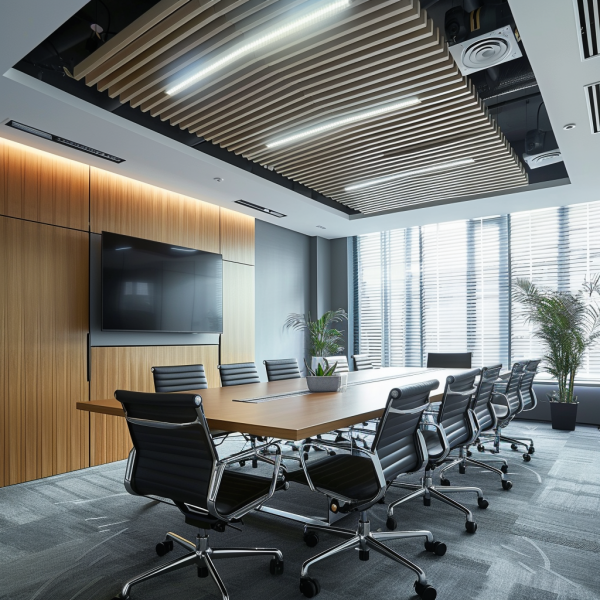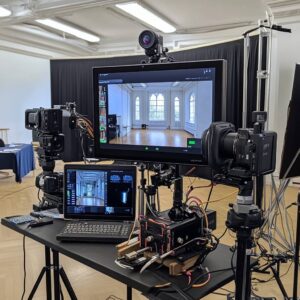Improving conference room sound quality
In today’s collaborative work environment, the quality of sound in conference rooms can significantly impact the effectiveness of meetings. Whether it’s a routine team check-in or a crucial client presentation, clear audio communication is essential. However, many find themselves grappling with common audio issues like echoes, reverberations, and intrusive background noises that can obscure critical discussions and disrupt the flow of ideas. This blog post explores practical solutions to enhance audio clarity and ensure your meetings are as productive as possible. From understanding acoustic challenges to implementing advanced technological solutions, we’ll guide you through the best practices for improving conference room sound quality.

Understanding acoustic challenges
Conference rooms often suffer from sound quality issues that can undermine the clarity of communication. Two of the most common acoustic challenges are echo and background noise. Echo occurs when sound waves bounce off hard surfaces like walls and tables, leading to a reverberation that muddles spoken words. Background noise, whether from outside traffic, HVAC systems, or office equipment, can also intrude into the space, further reducing audio intelligibility.
These acoustic issues not only make it difficult to hear but can also cause fatigue and frustration among participants, potentially derailing the productivity of meetings. By identifying and addressing these challenges, businesses can significantly enhance the auditory experience, making every discussion clearer and more engaging.

Key strategies for enhancing sound quality
Improving the sound environment in a conference room involves several strategic adjustments and installations. Here are key methods to consider:
- Acoustic Treatments: Installing acoustic panels or tiles on walls and ceilings can dramatically reduce echoes and reverberations. These materials absorb sound rather than reflect it, enhancing speech clarity. For best results, focus on areas directly opposite the main sound sources.
- Speaker and Microphone Placement: Proper placement is crucial for optimal sound delivery and reception. Speakers should be positioned to evenly distribute sound throughout the room without causing feedback or echo. Microphones should be placed close enough to catch clear audio from speakers without picking up excessive background noise. Consider using directional microphones that focus on the speaker and minimize other noises.
- Soundproofing Techniques: To prevent external noises from disrupting meetings, reinforce windows and doors with soundproofing materials. Simple adjustments like adding seals to door gaps and using double-pane glass for windows can make a significant difference.
By integrating these strategies, any conference room can improve sound quality, ensuring that every voice is heard clearly and without interference.

The role of technology in sound optimization
Advancements in audiovisual technology have made it easier to manage and enhance sound quality in conference rooms. One key component is the Digital Signal Processor (DSP), which optimizes the audio signal for clarity and volume without distortion. DSPs can automatically adjust levels and apply filters to reduce noise and feedback, making them essential for maintaining consistent sound quality during meetings.
Incorporating modern AV equipment, such as smart microphones and automated sound systems, can also play a significant role. Smart microphones are designed to enhance voice capture while minimizing background noise. Automated systems can adjust settings based on the number of attendees or the room’s specific layout, ensuring optimal sound at all times.
By leveraging these technological solutions, businesses can improve the quality of their audio and enhance the overall meeting experience, making communication seamless and more effective.
Maintenance and professional assessment
Regular maintenance of audiovisual equipment is crucial for ensuring that your conference room consistently delivers high-quality sound. This includes routine checks and updates of all components, such as microphones, speakers, and connections. It’s important to address any signs of wear or damage immediately to prevent unexpected failures during important meetings.
In addition to maintaining existing equipment, it’s beneficial to periodically assess the overall sound system setup. This might involve consulting with professional AV technicians who can evaluate the acoustics of the room and suggest improvements or upgrades. A professional assessment can help identify underlying issues that may not be obvious, such as the need for better acoustic treatment or more advanced technology.
Taking these steps not only helps maintain optimal sound quality but also ensures that the conference room environment is equipped to handle the demands of modern business communications.

Elevate your conference room experience
Ensuring excellent sound quality in your conference room transcends merely installing the right equipment; it’s about crafting an environment where communication flourishes. By understanding and addressing acoustic challenges, strategically utilizing advanced technology, and consistently maintaining your AV systems, you can dramatically enhance the clarity and effectiveness of every meeting. RYGID AV stands at the forefront of customized conference room audio-visual solutions, offering both expert guidance and advanced technologies tailored to meet your specific needs. Contact us to explore how our services can transform your conference room into a hub of seamless and efficient communication.



